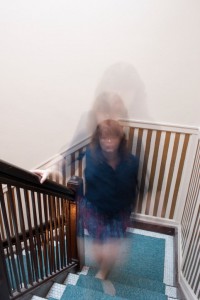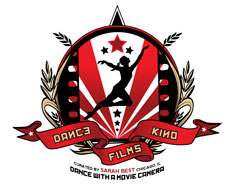
Dance Films Kino is a three-week project that I am presenting as an artist in residence at Hyde Park Art Center, March 4-25, 2012. Over three weeks, I will present 30 works of dance on film, as well as over a dozen live music, dance, and literary readings. All of the programs will be free to the public.
The seeds of this project were planted ten years ago, back when I was a MAPH student sitting in Yuri Tsivian’s intro to film class, learning about how filmmakers whose works were censored, or considered to be too experimental for mainstream distribution, showed films out of their own homes.
The films and performance I am presenting will be shown in an environment inspired by “kinos”, underground, avant-grade art clubs of the 1920s and 30s. I’m currently getting ready to paint the walls of my residency studio red, put out the caberet tables, and art deco objects I’ve sourced from Etsy. I’m creating artwork inspired by movement to hang on the walls of the space.
My first goal is to show movies in a place that feels like someone’s home, so that people are a little more willing to give something they’ve never seen before a try. My second goal is to bring all kinds of artists, writers, musicians, dance makers and filmmakers together to create a lot of different points of access into the work.
My third goal is to invite people to help create the space by imagining what it would be like to be a part of an underground society, to feel nostalgia for a fictional place situated in the past. I think there is a collective desire to engage in this type of activity. I think it is part of the reason why bars inspired by speakeasies are so popular, and why people like to fantasize about travel, even in tough economic times.
More on how Sarah arrived at this point after the jump
Dance is something I came to through many hours of volunteer work, rather than by exposure to performances. In between my years as an undergraduate at New York University and my first years in Chicago (I moved here in 2002, right after graduating, to start MAPH) I logged about seven years worth of internships and volunteer work.
When I moved to Chicago, I didn’t know a thing about dance. But as a volunteer at Links Hall, a dance venue in Wrigleyville, selling tickets to people’s shows, bumping into dancers in lobbies and dressing rooms, being at every performance, I started to make dancer friends. I saw more and more work, I asked questions, I developed a sense of what I liked and didn’t like. I fell into conversations. By the time I started writing about dance, producing and curating it, I knew who to call and what work to choose.
My early experiences, curating arts festivals in high school and college, taught me that curating across disciplines was a smart way to bring different types of people together, and to create many points of access into the work. When I curated a monthly reading series at NYU, people came because of the bands we presented, but they stayed to hear the poets read.
My own artwork is also multidisciplinary in nature and it took time to accept that being a multidisciplinary artist with a non-traditional career path was “okay” or even a good thing.
When I left MAPH, I had failed to become an academic, and I didn’t have a job but I knew two things deep down in my gut: that I needed to make art rather than study it, and that I didn’t, at that moment in time, know how to become a successful artist or what success would even look like for me.
All I can say is that I threw myself into it. I might have, in my private life post-MAPH, been totally miserable, and broke, and feeling really uncertain about what I wanted to do to “when I grew up”, but there I was, on stage next to Mayor Daley, dressed in a kimono wearing David Bowie makeup because I’d responded to a call for volunteers for a Redmoon Spectacle that was to celebrate the opening of Millennium Park.
I just kept at it. Later that year I marched in three Fourth of July parades wearing naught but a union suit and giant papier mache baby head in the name of art of patriotism.
I took classes that, as an introvert, I was terrified of taking. With people whom I presumed actually knew what they were doing. There was the time that my LeCoq trained physical performance teacher applauded me for creating a true moment of drama, when in fact, I was just getting winded from being chased by a professional actor through an invisible obstacle course. I was getting slower and slower, and he was getting more and more frustrated.

I took classes in mask-making, physical theater, performance art, textile art, photography, and printmaking.
I took a class with Goat Island, a company whose performance work was inspired by all kinds of things: architectural spaces, obscure literary quotes, computer code, Lenny Bruce.
Taking that class I learned that what I wanted to do was make visual art, not get on stage, but that it was okay for my work to be deeply informed by movement. It was satisfying to engage with a really rich creative process that let a lot of different forms of inspiration in.
There is a lot of pressure in the art world, just as there is in the academic world, to achieve success in a very specific way: to pick a discipline; to get an art degree from a prestigious institution in that discipline; to create work that is on trend or to relentlessly pursue a single subject; to only show your work at certain galleries; to price your work for a certain type of collector; and to strive for perfection. I learned about these pressures from my friends who’d graduated from art school.
By relentlessly having at it, not ever really knowing where I was heading, I arrived at a place where it was more important to me to gain new technical skills as an artist than it was to get a degree. I started to care more about showing my work in galleries that my friends own, where there’s always good beer, and good company, and work that I respect and am intrigued by, than I cared about how “good” my CV looked.
That doesn’t mean that I still don’t wrestle with anxiety. I was terrified to approach the Director of Exhibitions at Hyde Park Art Center about whether I could present what some part of me felt was a totally crazy idea. (Seriously, can you imagine asking someone whether it’s okay to build a Soviet bar in the middle of their museum?)
I was equally terrified to cold call the Executive Director of the Chicago Dancing Festival to see if there was a way we could work together (there was – I emceed their inaugural program of dance on film and am co-curating their second annual program this coming July).
I am currently doing what I can (exercising, meditating, taking nights off) to manage my anxiety about what people will think of the art work that I am producing for the space.
It’s just that I don’t ever stop trying.
There are days when I have fantastic successes that I want to yawp off of rooftops (or more likely proclaim to Facebook), like the day someone gave me a couple of thousand dollars because they thought my idea for the kino was a really great one. There are days when I have major set backs: when I got the rejection letter for the grant I really needed, the day when I had to sign over my firstborn to get a large photographic work professionally framed, the day I learned one of the press releases about the project was going out about two months late. Crap! I hate when that happens!
More often, there are days when I wish that I didn’t have to work two or three nights a week on top of having a demanding day job, and that I could just kick back and watch “Khloe and Kim Take New York” with a joyful sense of abandon like a “normal” person.
I just keep going. Some days are better than others.
I once heard the photographer Carrie Mae Weems talk about this concept of “economy of scale”. Ms. Weems makes really powerful work, but she often uses her own home as a photo studio (some of her iconic works are set at her dinner table). She also often uses her own body in her work, because, she says, she knows how photographing someone else can make them feel. She talked about certain male photographers who travel with huge crews, running their photo shoots like they were movie sets, delegating work to assistants rather than having their own hand in it. Carrie Mae Weems doesn’t think that you need a hundred assistants to make meaningful work and to be successful.
I think the point is that you have to make your own path based on what, in your gut, you feel is really crucial to your happiness, and that there are going to be days on that so-called path to happiness that still kind of suck. I have learned that terror often precedes major breakthroughs; that sometimes it is helpful to have an antagonist in your life; and that you have to commit to being disciplined and living your life in equal measure in order to not feel chronically stressed out (Sorry Kardashians, I can only watch your reality shows or contemplate your general welfare on Mondays and Tuesdays. Sorry important filmmakers, I can only respond to your emails on Wednesdays and Thursdays).
One of the biggest lessons that I have learned is that while you’re slogging through, you’ve got to celebrate the really minor victories. I don’t mean collapsing in a heap because you’re tired and ordering take out, which is a sort of nice change from the microwave Healthy Choice meals you’ve been eating as of late. I mean you’ve got to say “I am celebrating this small thing that I’ve accomplished. See, here I am, I’m really doing it. I’m celebrating it because it’s pretty awesome thing I just did.” If you wait for the “big payoff” of finishing your thesis, or reaching a certain point in your career, you’re going to continuously feel like a failure and feel kind of pissed that you don’t have business cards with a badass title on them.
Who cares about the business cards? My friend Jennifer once gave me a business card with a frog in a bucket on it which said “Jennifer Keeney, In Between Jobs”.
Having a sense of humor helps. You just keep going.
I invite you to join me at Dance Films Kino, March 4-25 at Hyde Park Art Center. All events are free and BYOB. For more information, visit: http://www.dancefilmskino.com

Leave a Reply